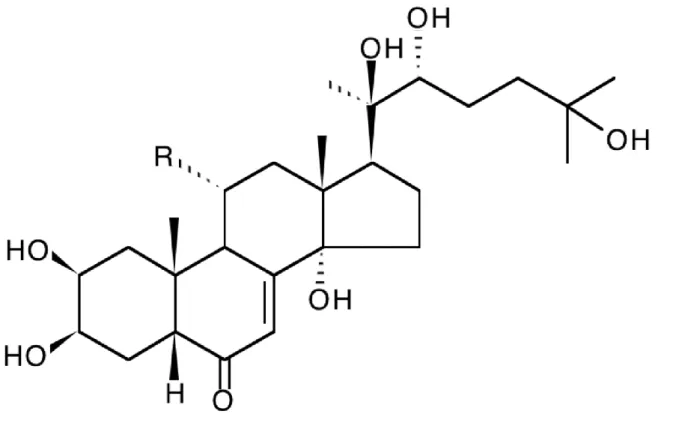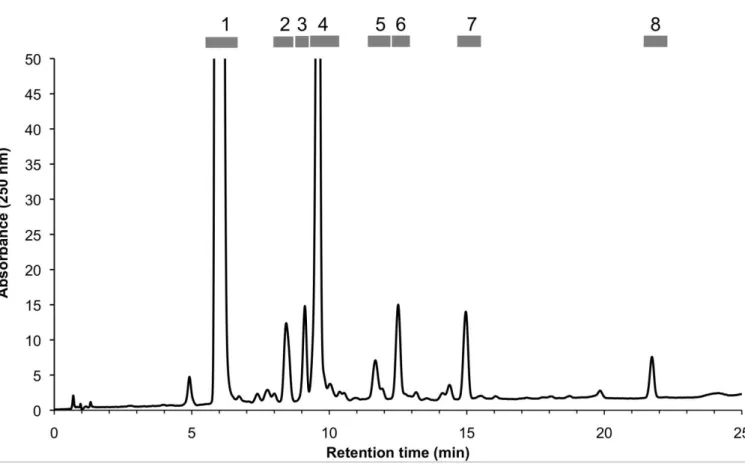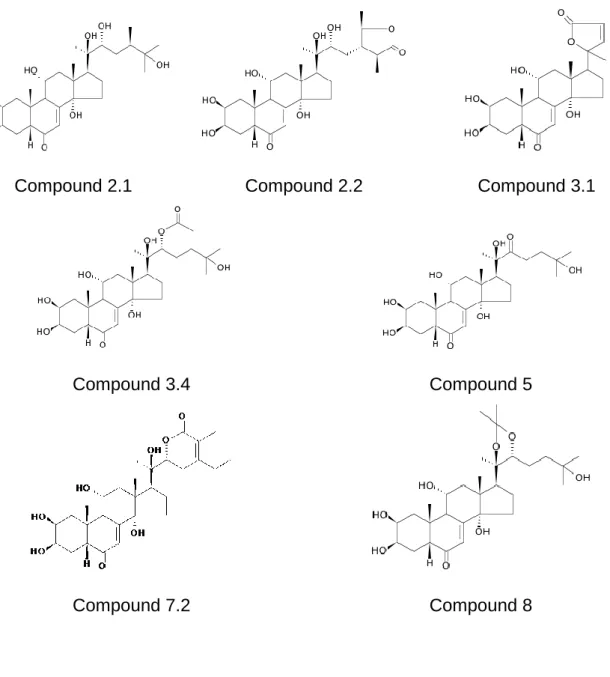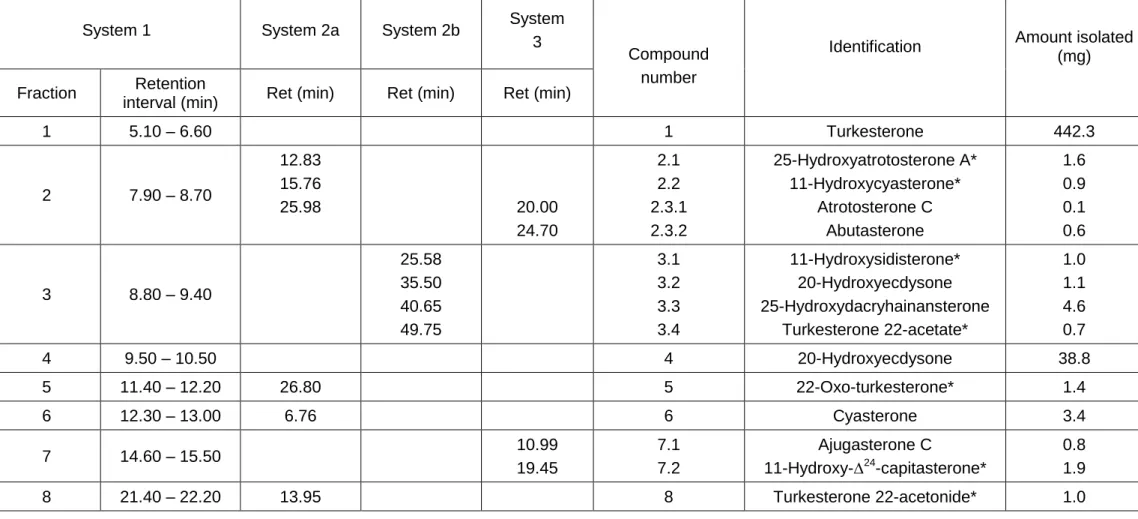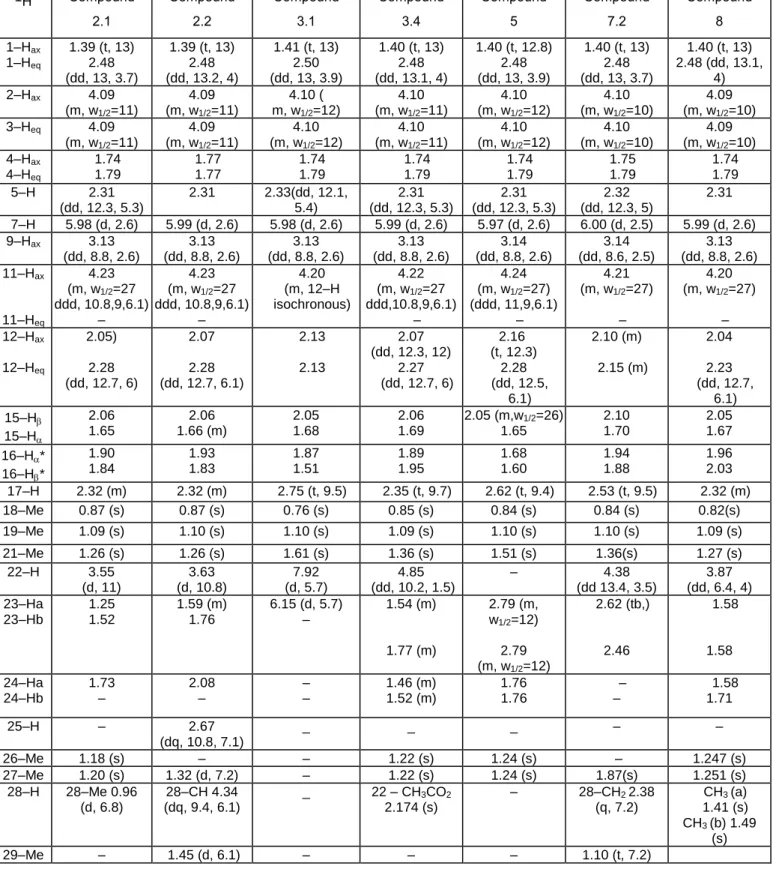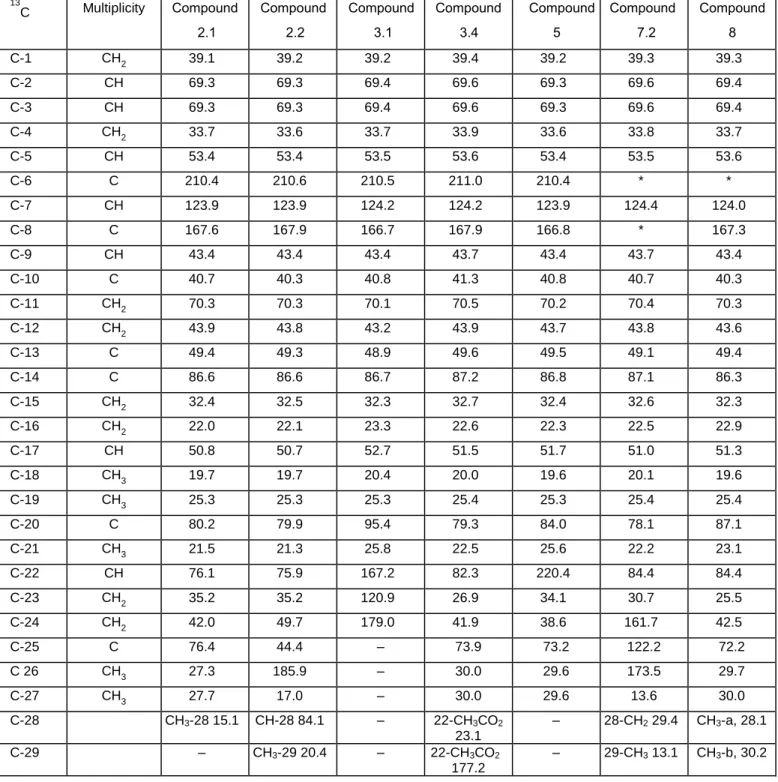HAL Id: hal-01157962
https://hal.sorbonne-universite.fr/hal-01157962
Submitted on 29 May 2015
HAL is a multi-disciplinary open access
archive for the deposit and dissemination of sci-entific research documents, whether they are pub-lished or not. The documents may come from teaching and research institutions in France or abroad, or from public or private research centers.
L’archive ouverte pluridisciplinaire HAL, est destinée au dépôt et à la diffusion de documents scientifiques de niveau recherche, publiés ou non, émanant des établissements d’enseignement et de recherche français ou étrangers, des laboratoires publics ou privés.
The minor ecdysteroids from Ajuga turkestanica
Louis Guibout, Nilufar Mamadalieva, Christine Balducci, Jean-Pierre Girault,
René Lafont
To cite this version:
Louis Guibout, Nilufar Mamadalieva, Christine Balducci, Jean-Pierre Girault, René Lafont. The minor ecdysteroids from Ajuga turkestanica. Phytochemical Analysis, Wiley, 2015, 26 (5), pp.293-300 �10.1002/pca.2563�. �hal-01157962�
The minor ecdysteroids from Ajuga turkestanica
Louis Guibout a,b, Nilufar Mamadalieva c, Christine Balducci b, Jean-Pierre Girault d and René Lafont a*
a
Sorbonne Universités, UPMC Univ Paris 06, IBPS-BIOSIPE, CNRS FR 3631, 7 Quai Saint Bernard, Case Courrier 29, 75252 Paris Cedex 05, France
b
Institut Biophytis, F-93230 Romainville, France
c
Institute of the Chemistry of Plant Substances, Mirzo Ulugbek Str. 77, Tashkent 100170, Uzbekistan
d
Université Paris Descartes, Laboratoire de Chimie et Biochimie Pharmacologiques et Toxicologiques, CNRS UMR 8601, 45 rue des Saints-Pères, F-75270 Paris Cedex 06, France *rene.lafont@upmc.fr
ABSTRACT
Introduction — Ajuga turkestanica is a plant used in traditional medicine for its high ecdysteroid content, including the presence of the particularly active turkesterone, which possess efficient anabolic activity.
Objectives —To isolate and identify minor ecdysteroids present in a semi-purified plant fraction containing ca. 70% turkesterone.
Material and Methods — Multi-step preparative HPLC (combining RP- and NP-HPLC systems) was used to purify the different components present in the turkesterone fraction. Isolated compounds were identified by high-resolution mass spectrometry and 2D-NMR.
Results — Fourteen ecdysteroids (including turkesterone and 20-hydroxyecdysone) were isolated. Seven of these, all bearing an 11-hydroxy group, were previously unreported.. Conclusion — Ajuga turkestanica ecdysteroids are characterized by the abundance of 11-hydroxylated compounds and by the simultaneous presence of 24C, 27C, 28C and 29C ecdysteroids. It is expected that even more ecdysteroids are to be found in this plant since the starting material for this study lacked the less polar ecdysteroids. The simultaneous presence of 20-hydroxyecdysone and turkesterone (its 11-hydroxy analogue) as the two major ecdysteroids suggests that every ecdysteroid is probably present in both 11-hydroxy and 11-deoxy forms.
Keywords: Ajuga turkestanica; Lamiaceae; phytoecdysteroid:
Introduction
Among the >300 known species of the genus Ajuga (Lamiaceae), ≥45 have been chemically investigated. A few of these have been studied in the context of their medical properties, owing to the presence of active molecules such as phytoecdysteroids, diterpenoids, sterols, iridoids, neoclerodanes, anthocyanins, other flavonoids and ionones (Israili and Lyoussi, 2009;
Mamadalieva et al., 2013). Ajuga turkestanica, is naturally growing in Uzbekistan and Tadzhikistan (Vvedenskiy, 1961; Ganiev et al., 1990), and it has been valued for a long time by the local population for its beneficial effects on muscle strength, muscular and stomach aches and its protective action against heart diseases (Cheng et al., 2008; Grace et al., 2008). Many effects have been documented concerning either extracts or pure compounds isolated from A.
turkestanica aerial parts or roots. Thus, extracts were shown to increase lactation in female rats
(Khalitova et al., 1998), to reduce hyperglycaemia in alloxan-induced diabetic rats (Kutepova et
al., 2001), to help skin wound healing (Syrov et al., 1994) or to display antiproliferative,
antimicrobial and antioxidant effects (Mamadalieva et al., 2013). Most of these effects are probably related to the presence of ecdysteroids (Dinan, 2009). Ecdysteroid-enriched extracts of A. turkestanica (or pure turkesterone) display anabolic effects on muscles (Syrov et al., 2001; Zubeldia et al., 2012), even in a sarcopenia context (Lawrence, 2012). In addition, turkesterone and 20-hydroxyecdysone have anti-stress and immunostimulating effects (Shakhmurova et al., 2010). Extracts of Ajuga turkestanica are already marketed for all these indications (e.g. AYUSTAN - http://5741.uz.all.biz/preparat-ayustan-g22268), and turkesterone-enriched extracts are sold on the internet for bodybuilders.
Ajuga turkestanica was one of the early plant species investigated for the presence of
ecdysteroids. Firstly, 20-hydroxyecdysone and cyasterone were isolated (Usmanov et al., 1971), then turkesterone (Usmanov et al., 1973, 1975) and several minor components i.e., ajugalactone (Saatov et al., 1977), cyasterone 22-acetate (Usmanov et al., 1978a), ajugasterone B (Usmanov et al., 1978b). More recently, ecdysone and 20-hydroxyecdysone 2,3-acetonide were also indentified (Saatov et al., 1999). Turkesterone and 20-hydroxyecdysone (figure 1) are the two major ecdysteroids, accounting each for ca. 0.2-0.4% of dry weight of aerial parts (Abdukadirov et al., 2005)
It is well-established that ecdysteroid-rich plants such as Silene otites (Báthori et al., 1999), or
Rhaponticum carthamoides (Kokoska and Janovska, 2009; Zhang et al., 2010) contain a
complex cocktail of various ecdysteroids. Given the high concentrations of ecdysteroids in A.
turkestanica (ca. 1% of dry weight), this plant was expected to contain a much larger set of
minor ecdysteroids than already described, and the present work has taken advantage of a medium-scale extraction experiment to isolate and identify additional minor ecdysteroids from this plant.
Materials and methods Plant material
Roots of A. turkestanica were collected in the Surkhan-Darya region of Uzbekistan and identified by Dr. O.A. Nigmatullaev at the Department of Herbal Plants (Institute of the Chemistry of Plant Substances, Uzbekistan) (voucher specimen number 20077092).
Extraction
Roots of A. turkestanica were air-dried in windy place at 23°C during one week after collection and them ground to a powder with a Waring blender. After grinding, plant material (2 kg) was triturated with methanol (3×6 L) during 3 days at room temperature (23°C). The solvent was evaporated (in a rotary vacuum evaporator at 40 °C) and concentrated, and 102 g of dried extract was obtained (yield was 5.1% of the dried plant material). Methanol (60 mL) was added to the dried methanol extract to fluidize it before diluting with water (1 L) and hydrophobic compounds were removed upon partition with chloroform (4x1 L) which was discarded. The water layer (1 L) was then extracted with n-butanol (5×1 L). The combined butanol extracts were evaporated to dryness under reduced pressure (at 46 °C).
The n-butanol fraction (42 g) was chromatographed over a silica gel column (silica particle size: 63 – 100 μm; Chemapol, Praha, Czech Republic). The column was packed using a simple dry-pack method. The n-butanol extract applied in dried form mixed with silica gel and carefully added to the top of the column. The column (1.6 kg silica, size 10×60 cm) was eluted with CHCl3/CH3OH (9:1 v/v, 4 L), and fraction X was obtained containing a mix of less polar
ecdysteroids. Continuous elution with CHCl3/CH3OH (6:1 v/v, 3 L) gave of fraction Y contained a
mixture of 20-hydroxyecdysone, turkesterone and some less polar ecdysteroids. Further elution with CHCl3/CH3OH (4:1 v/v, 4 L) gave a polar fraction Z, which contained a small amount of
turkesterone and iridoids. Eluates were checked by TLC. TLC was performed on aluminium foil-backed plates (Fluka, Sigma-Aldrich, Germany). Developing solvent was chloroform–methanol– water at 4:1:0.1 (v/v/v). Spots were visualized under UV light (254 nm) and by spraying with vanillin/H2SO4 reagent followed by heating to 120 °C for 10 min (Báthori and Kalász, 2001).
Fractions X and Y were combined and after evaporating the solvent under reduced pressure, an ecdysteroid-containing fraction (turkesterone + 20-hydroxyecdysone + less polar ecdysteroids) of 8.3 g was obtained.
HPLC separations
An aliquot (700 mg) of the above extract was purified by preparative reversed-phase HPLC (System 1).
Preparative RP-HPLC step (System 1): LC-MS Prep Agilent 1100, Column Sunfire Prep C18 OBD 100 x19 mm (5 µm) from Waters; Linear gradient: A = ACN, B = H2O+0.1%HCOOH (T=0
10% A - 90% B; T=25 min 35% A - 65% B; T=26 min 10% A - 90% B; T=30 min 10% A - 90% B); Flow-rate = 20 mL.min-1; detection: UV, wavelength = 254 nm. The extract was dissolved in 35 mL of ACN/H2O (10/90,v/v). 14 aliquots of this solution were injected into the LC-MS Prep.
Fractions were collected using an automatic collector (Agilent Prep-FC G1346B) with a time-based trigger mode. Collected peaks were dried using a HT4-Genevac without heating.
The purity of the above fractions was checked by analytical NP-HPLC (column ACE 5 SIl, 150 x 4.6 mm) eluted at 1 mL.min-1 using either dichloromethane-isopropanol-water (125:40:2.5 v/v/v) or cyclohexane-isopropanol-water (100:40:2.5 v/v/v). Those giving a single peak with both systems were considered as pure enough. Those giving several peaks were further fractionated using the most appropriate NP-HPLC solvent with a semi-preparative Zorbax-SIL column (250 x 9.4 mm) eluted at 4 mL.min-1 using three different solvent systems: dichloromethane-isopropanol-water (125:40:2.5 v/v/v) (system 2a), dichloromethane-dichloromethane-isopropanol-water (125:30:2 v/v/v) (system 2b), and cyclohexane-isopropanol-water (100:40:2.5 v/v/v) (system 3); detection: UV, wavelength = 254 nm. In some cases, two NP-HPLC steps were required to obtain pure compounds.
HPLC-MS analyses
Analytical HPLC-MS used a LC1100 Agilent system with a Sunfire column (50 x 4.6 mm). Elution was performed in the gradient mode: acetonitrile-0.1% TFA in H2O, linear gradient 10 to
35% acetonitrile in 25 min, flow-rate = 0.5 mL.min-1. The mass spectrometer was an API 365 equipped with a Turbo Ion Spray source.
HRMS analyses
High-resolution p-ESI (probe electrospray ionization) mass spectra were acquired with an ultra-high resolution mass spectrometer, a hybrid linear ion trap LTQ-Orbitrap (Thermo Fisher Scientific, Les Ulis, France). Individual compounds dissolved in methanol were directly infused in the mass spectrometer. For each compound, we observed ions corresponding to [M+Na]+ (major), [M+K]+ (medium) and [M+H]+ (minor).
NMR analyses
All NMR spectroscopy experiments were recorded on a Bruker AVANCE II 500 Spectrometer in D2O (500 MHz for
1
H and 125 MHz for 13C), at 300K (Girault, 1998). Presaturation of the solvent was used for all 1D and homonuclear 2D 1H experiments. 2D-experiments (1H, TOCSY [spin lock time 15ms and 35ms], NOESY [mixing time 500 ms], HSQC [one bond correlation 1J1H-13C] and HMBC [1H-13C correlation via two or three bonds via 2J1H-13C or 3J1H-13C, long-range delay 80 ms]) were performed by Pulse Field Gradient (PFG) methods using standard Bruker software. The samples were lyophilized and dissolved in D2O. The sodium salt of
3-(trimethylsilyl)[2,2,3,3-d4] propionic acid (TSP-d4) was used as internal reference for the proton and carbon shifts. For 1H 1D measurements, spectral width of 6009.6 Hz and 32K data points were used to yield the Fid corresponding to a digital resolution of 0.0004 ppm/point (0.18 Hz/point). So for signals assigned directly from 1H 1D measurements accurate values of the chemical shifts could be given ± 0.001 ppm. However, for 1H 2D measurements (TOCSY or NOESY), the same spectral width in F2 (1H) of 5000 Hz was used and all data points (t2 x t1) were acquired with 4K x 256. For F1, linear prediction to 4 times t1 was applied to enhance the resolution. With these conditions, the digital resolutions are 0.005 ppm/point and 0.01 ppm/point for F2 and F1, respectively. In the case of heteronuclear experiments (HSQC and HMBC), the same spectral width in F2 (1H) of 5000 Hz was used for both. Spectral widths in F1 (13C) of 20120 Hz and 28923 Hz for HSQC and HMBC, respectively were used. All data points (t2 x t1) were acquired with 4K x 256 (or 160), and linear prediction to 4 times t1 was applied to enhance the resolution in F1. In these conditions, the digital resolutions for F2 (1H) are 0.005 ppm/point for HSQC and HMBC, 0.1 ppm/point for F1 (13C) HSQC and 0.2 ppm/point for F1 (13C) HMBC.
Results and discussion Isolation of ecdysteroids
Preparative HPLC (system 1) allowed the separation and collection of 8 fractions (Figure 2 and Table 1). The purity of each fraction was checked by analytical NP-HPLC-UV. Fractions 1 (= turkesterone), 4 (= 20-hydroxyecdysone), 5, 6 and 8 contained a single major compound. The three remaining fractions (2, 3 and 7) were mixtures (see supplementary figure 1) and were further fractionated using one or two additional semi-preparative NP-HPLC steps as described in Table 1. NP-HPLC was also used to improve the purity of fractions 5 and 6 and remove minor contaminants. Finally, 14 pure compounds were isolated as amorphous powders and identified by HRESIMS and NMR.
Seven of the 14 have already been described in the Ecdybase (Lafont et al., 2002) i.e., turkesterone (compound 1), atrotosterone C (compound 2.3.1), abutasterone (compound 2.3.2), 20-hydroxyecdysone (compounds 3.2 and 4), 25-hydroxydacryhainansterone (compound 3.3), cyasterone (compound 6) and ajugasterone C (compound 7.1). The corresponding data are provided as supplementary material. Seven other ecdysteroids were isolated for the first time, and their identification is described below.
Identification of the newly isolated ecdysteroids
The structures of the new ecdysteroids are given in figure 3. Their 1H and 13C NMR data are given in Tables 2 and 3. Full NMR spectra are provided in the supplementary materials for turkesterone and the 7 new ecdysteroids. All the new compounds isolated in this work present a 5-Hsteroid nucleus with an 11-hydroxy (equatorial) substituent identical with turkesterone, which result in typical signal characteristics as described for turkesterone (see supplementary
material and figure s3). Thus the modifications concern only their side-chain with respect to turkesterone.
25-Hydroxyatrotosterone A (Compound 2.1 - 1.6 mg)
Turbo Ion Spray-MS gives positive ions at m/z 511 (M+H)+, 493 (MH-H2O)+, 475 (MH-2H2O)+,
457 (MH-3H2O)+ and 439 (MH-4H2O)+. HR-ESIMS positive ion was observed for M+Na+ at m/z
533.30800 (m/z expected for C28H46O8Na 533.30849, ∆ = - 0.92 ppm). The compound formula
is C28H46O8,which indicates that it bears one additional carbon and two extra hydrogen atoms
with respect to turkesterone. Examination of the 1D 1H NMR spectrum shows a new methyl signal doublet at 0.96 ppm, (d, 6.8 Hz) bound to CH-24 (figure s4). This CH-24 is assigned from HMBC correlations observed with 1H of 26-Me and 27-Me methyl signals. 1H and 13C NMR signals of methyls 26 and 27 correspond to values in agreement with 25 hydroxylated ecdysteroids. This is confirmed from HMBC correlations observed with 1H of 26, 27, 28 methyl signals with the same 13C NMR signal at 76.4 ppm thus assigned unambiguously to C-25. Moreover, 1H and 13C NMR signals of the side-chain are identical with those of makisterone A, both recorded in D2O (Bakrim et al., 2014), suggesting that the configuration of the asymmetric
center at C-24 is equivalent for these two compounds. Thus, the structure was assigned as 25-hydroxyatrotosterone A.
11-Hydroxycyasterone (Compound 2.2 - 0.9 mg)
Turbo Ion Spray-MS gives positive ions at m/z 537 (M+H)+, 519 (MH-H2O)+, 501 (MH-2H2O)+,
483 (MH-3H2O)+ and 465 (MH-4H2O)+. An HR-ESIMS positive ion was observed for M+Na+ at
m/z 559.28768 (m/z expected for C29H44O9Na 559.28775, ∆ = – 0.13 ppm). The compound
formula corresponds therefore to C29H44O9, thus it has two additional carbons and one
extra-oxygen with respect to turkesterone. Examination of 1D and 2D 1H NMR spectra (figure s5) shows two methyl signal doublets, one at 1.32 ppm, (d, 7.2 Hz) J coupled to the oxymethine group CH-25, with its 1H signal 25-H at 2.67 ppm, (dq, 10.8, 7.1 Hz) and the other one at 1.45 ppm, (d, 6.1 Hz), J-coupled to oxymethine group CH-28, with its 1H signal H-28 at 4.34 ppm, (dq, 9.4, 6.1 Hz). HMBC show that these two methyl signals are correlated to the same carbon, assigned unambiguously as CH-24 from HMBC correlation 22-H => C-24. Moreover, 24-H presents the reverse HMBC correlation 24-H => C-27 and C-29 to the 13C signals of these two methyl groups. The 1H methyl signal at 1.32 ppm presents an HMBC correlation with the 13C signal of an ester carbonyl group at 185.9 ppm. All these elements lead us to propose a side-chain with a lactone group as in cyasterone. Moreover, the 1H and 13C NMR data, when compared with those of cyasterone in D2O, show that these two compounds have identical
side-chains. Side-chain 1H and 13C chemical shifts and both HMBC and NOESY experiments show identical values and correlations to those observed for cyasterone, suggesting equivalent stereochemistry of the lactone ring. Thus, the structure was assigned as 11-hydroxycyasterone.
11-Hydroxysidisterone (Compound 3.1 - 1.0 mg)
Turbo Ion Spray-MS gives positive ions at m/z 433 (M+H)+, 415 (MH-H2O)+, 397 (MH-2H2O)+,
379 (MH-3H2O)+ and 361 (MH-4H2O)+. An HR-ESIMS positive ion is observed for M+Na+ at m/z
455.20418 (expected for C24H32O7Na 455.20402, ∆ = + 0.35 ppm), thus the compound formula
is C24H32O7. The compound presents the samesteroid nucleus as turkesterone. It is a C24
ecdysteroid lacking 3 carbon atoms, 1 oxygen atom and 12 hydrogen atoms when compared to turkesterone. Again, examination of 1H and 13C NMR data (figure s6) show that side-chain modifications with respect to turkesterone correspond to 3 supplementary unsaturations (or equivalents). Examination of the 1D 1H NMR spectrum shows two new ethylenic 1H signals at 7.92 ppm, (d, 5.7 Hz) and 6.15 ppm, (d, 5.7 Hz) which are J-coupled together. HMBC shows that 17-H at 2.75 ppm (t, 9.5) is correlated to carbon signals of the side-chain corresponding to C-20 (95.4 ppm), C-21 ( 25.8 ppm) and C-22 (167.2 ppm), this last one corresponding to the chemical shift of an ethylenic carbon bond. From a HSQC, the 1H signal at 7.92 ppm could be assigned as 22-H. From HMBC, 22-H is correlated to carbon signals of the end of the side-chain corresponding to C-23 (120.9 ppm), an ethylenic carbon, and C-24 (179.0 ppm), a typical
value for a carbonyl ester or a lactone group. These elements suggest that a cyclic structure is present in the side-chain, corresponding to a five-membered lactone ring with a double bond between C-22 and C-23, similar to that of sidisterone (Girault et al., 1996). Comparison with 1D and 2D 1H and 13C NMR data for the side-chain of sidisterone in D2O (Bakrim et al., 2014)
shows perfect agreement indicating that the compound is 11-hydroxysidisterone and suggesting that the configuration of the asymmetric centre at C-20 is equivalent for these two compounds.
Turkesterone 22-acetate (Compound 3.4 - 0.7 mg)
Turbo Ion Spray-MS gives positive ions at m/z 539 (M+H)+, 503 (MH-2H2O)+, 485 (MH-3H2O)+,
479 (MH-CH3COOH)+, 443 (MH-2H2O-CH3COOH)+, 425 (MH-3H2O-CH3COOH)+ and 407
(MH-4H2O-CH3COOH)+. An HR-ESIMS positive ion is observed for M+Na+ at m/z 561.30318 (m/z
expected for C29H46O9Na 561.30340, ∆ = – 0.39 ppm). The compound formula is therefore
C29H46O9.It is a C29 ecdysteroid with two carbons, one oxygen atom and two hydrogen atoms
more than turkesterone. Again, 1H and 13C NMR data (figure s7) show only side-chain modifications with respect to turkesterone. Examination of the 1D 1H NMR spectrum shows a new methyl signal singlet at 2.17 ppm (s), typical of an acetate group. This is confirmed by HMBC, which shows that this methyl is correlated to a quaternary ester carbonyl at 177.2 ppm. The presence of this acetate group at C-22 is confirmed by the large high frequency (downfield) shift of the 22-H signal (4.85 ppm, dd, 10.2, 1.5 Hz) with respect to turkesterone or 20-hydroxyecdysone. This leads to the conclusion that the compound is turkesterone 22-acetate.
22-Oxo-turkesterone (Compound 5 - 1.4 mg)
Turbo Ion Spray-MS gives positive ions at m/z 495 (M+H)+, 477 (MH-H2O)+, 459 (MH-2H2O)+,
441 (MH-3H2O)+ and 423 (MH-4H2O)+. An HR-ESIMS positive ion is observed for M+Na+ at m/z
517.27681 (m/z expected for C27H42O8Na 517.27719, ∆ = – 0.73 ppm). The compound formula
is C27H42O8, with two missing hydrogen atoms with respect to turkesterone. The side-chain
modification with respect to turkesterone corresponds to one supplementary unsaturation. Examination of the 1D 1H NMR spectrum (figure s8) shows disappearance of the 1H signal for 22-H and large high frequencies (downfield) shifts of both 23-Ha,b of the side-chain (2.79 ppm) with respect to turkesterone. Moreover, HMBC shows that the 21-methyl is correlated to a quaternary carbonyl at 220.4 ppm, a typical value for a ketonic carbonyl, which leads us to conclude that it is a 22-oxo derivative. So, the structure corresponds to 22-oxo-turkesterone.
11-Hydroxy-∆24
-capitasterone (Compound 7.2 - 1.9 mg)
Turbo Ion Spray-MS gives positive ions at m/z 519 (M+H)+, 501 (MH-H2O)+, 483 (MH-2H2O)+,
465 (MH-3H2O)+, 447 (MH-4H2O)+ and 429 (MH-5H2O)+. An HR-ESIMS positive ion was
observed for M+Na+ at m/z 541.27651 (m/z expected for C27H42O8Na 541.27719, ∆ = –
1.27 ppm). The compound formula is therefore C29H42O8. The modifications with respect to
turkesterone correspond to 3 supplementary unsaturations or equivalents. Examination of 1D and 2D 1H NMR spectra (figure s9) shows 2 new 1H methyl signals. One is a triplet (overlapping the 19-Me singlet) at 1.10 ppm, (t, 7.2) J-coupled to a CH2 group at 2.38 ppm (q, 7.2). This
chemical shift corresponds to a CH2 group linked to an ethylenic double bond in agreement with
a CH3-CH2-C=C< motif. The other methyl signal is a singlet at 1.87 ppm (sb), and such a
chemical shift corresponds to a methyl linked to an ethylenic double bond. Moreover, HMBC shows that this methyl signal (1.87 ppm) is correlated to two ethylenic carbon signals at 122.2 and 161.7 ppm and with the 13C signal of an ester carbonyl group at 173.5 ppm. The CH2 group
at 2.38 ppm is also correlated to the same two ethylenic carbon signals. All this leads us to propose a structure for the side-chain of an α,β-unsaturated lactone. The 22-H signal shows a large high frequency (downfield) shift at 4.38 ppm (dd, 13.4, 3.5) with its corresponding CH-22 signal at 84.4 ppm, and these values are in agreement with a lactonization involving the 22-hydroxyl group to obtain a six-membered α,β-ethylenic lactone. This lactone structure is confirmed by all the data obtained from HMBC, HSQC and NOESY and TOCSY experiments. So, the structure of this compound is related to that of capitasterone, a C29 ecdysteroid bearing
a six-membered lactone ring (Takemoto et al., 1968). Thus, its structure corresponds to 11-hydroxy-∆24
-capitasterone.
Turkesterone 20,22-acetonide (Compound 8 - 1.0 mg)
Turbo Ion Spray-MS gives positive ions at m/z 537 (M+H)+, 519 (MH-H2O)+, 483 (MH-3H2O)+,
479 (MH-(CH3)2CO)+, 461 (MH-H2O-(CH3)2CO)+, 443 (MH-2H2O-(CH3)2CO)+, 425 (MH-3H2
O-(CH3)2CO)+ and 407 (MH-4H2O-(CH3)2CO)+. An HR-ESIMS positive ion is observed for M+Na+
at m/z 559.32346 (m/z expected for C30H48O8Na 559.32414, ∆ = – 1.22 ppm). 1H and 13C NMR
data show a single side-chain modification with respect to turkesterone, corresponding to one supplementary unsaturation or equivalent. Examination of 1D 1and 2D 1H NMR spectra (figure s10) shows 2 new 1H singlet methyl signals at 1.41 ppm (s) and 1.49 ppm (s). Moreover, HMBC shows that these two 1H methyl signals are correlated to the same quaternary carbon atom at 109.8 ppm, a typical value for a quaternary carbon of an acetonide group. This acetal group was easily located as bridging 20-O and 22-O, as we observe a shift of both C-20 and C-22 to higher frequencies (downfield) at 87.1 and 84.4 ppm, respectively, and similarly for the 1H-22 signal at 3.87 ppm (dd, 6.4, 4 Hz). These findings lead to the straightforward conclusion that it is a 20-22 acetonide derivative. Therefore, the compound corresponds to turkesterone 20,22-acetonide.
Thus A. turkestanica contains a complex cocktail of ecdysteroids, and additional studies on less polar fractions will probably allow the isolation of even more compounds.
Acknowledgements
The work presented here was co-funded by the BPI, FUI (French State Fund), Ile de France Region and Seine-Saint-Denis General Council. Dr Laurence Dinan is deeply acknowledged for critical reading of the manuscript and language improvement.
Thanks are due to the colleagues who provided us reference ecdysteroids - Dr Pinheiro (abutasterone) and Dr Harmatha (ajugasterone C)
REFERENCES
Abdukadirov IT, Yakubova MR, Nuriddinov KhR, Mamatkhanov AU, Turakhozhaev MT. 2005. Ecdysterone and turkesterone in Ajuga turkestanica determined by HPLC. Chem Nat Comds 41(4):475-476.
Bakrim A, Ngunjiri J, Crouzet S, Guibout L, Balducci C, Girault J-P, Lafont R. 2014. Ecdysteroid profiles of two Ajuga species, A. iva and A. remota. Nat Prod Commun 9(8):1069-1074.
Báthori M, Girault JP, Kalasz H, Mathé I, Dinan LN, Lafont R. 1999. Complex phytoecdysteroid cocktail of Silene otites (Caryophyllaceae). Arch Insect Biochem Physiol 41:1-8.
Báthori M, Kalász H. 2001. Separation methods for phytoecdysteroids. LC-GC Europe, October 2001:2-7.
Cheng DM, Yousef GG, Grace MH, Rogers RB, Gorelick-Feldman J, Raskin I, Lila MA. 2008. In
vitro production of metabolism-enhancing phytoecdysteroids from Ajuga turkestanica. Plant Cell Tiss Organ Cult. 93:73-83.
Dinan L. 2009. The Karlson lecture. Phytoecdysteroids: what use are they? Arch Insect
Biochem Physiol 72:126-141.
Ganiev ShG, Khamidkhodjaev SA, Djuharova MX, Saatov Z. 1990. Ajuga turkestanica from Baysuntay (Baysun mountain). Uzbek Biol J:30-32 [in Russian].
Girault J-P. 1998. Determination of ecdysteroid structure by 1D and 2D NMR. Russ J Plant
Physiol 45:306-309.
Girault J-P, Báthori M, Kalasz H, Mathé I, Lafont R. 1996. Sidisterone, a C-24 ecdysteroid from
Silene dioica and Silene otites. J Nat Prod 59:522-524.
Gorelick-Feldman J. Phytoecdysteroids – Understanding their Anabolic Activity. PhD Thesis. Graduate School-New Brunswick Rutgers, The State University of New Jersey. 2009. 143 pp. Gorelick-Feldman J, MacLean D, Ilic N, Poulev A, Lila MA, Cheng D, Raskin I. 2008. Phytoecdysteroids increase protein synthesis on skeletal muscle cells. J Agric Food Chem 56:3532-3537.
Grace MH, Cheng DM, Raskin I, Lila MA. 2008. Neo-clerodane diterpenes from Ajuga
turkestanica. Phytochem Lett 1:81-84.
Israili ZH, Lyoussi B. 2009. Ethnopharmacology of the plants of genus Ajuga. Pak J Pharm Sci 22(4):425-462.
Khalitova YD, Syrov VN, Akhmedkhodjaeva KhS, Mamatkhanov AU. 1998. Possible use of the extract of Ajuga turkestanica as a remedy contributing to lactation. Dokl Akad Nauk Respubliki
Uzbekistan 8:35-38.
Kokoska L, Janovska D. 2009. Chemistry and pharmacology of Rhaponticum carthamoides: a review. Phytochemistry 70:842-855.
Kutepova TA, Syrov VN, Khushbaktova ZA, Saatov Z. 2001. Hypoglycemic activity of the total ecdysteroid extract from Ajuga turkestanica. Pharm Chem J 35(11):608-609.
Lafont R, Harmatha J, Marion-Poll F; Dinan L, Wilson ID. 2002. Ecdybase, a free ecdysteroid database. http://ecdybase.org.
Lawrence MM. 2012. Ajuga turkestanica as a countermeasure against sarcopenia and dynapenia. MS Thesis, Appalachian State University.
Mamadalieva NZ. 2013. Phytoecdysteroids: chemistry and occurrence. In: Natural compounds:
Plant Sources, Structure and Properties, Eds. Azimova, S.S, Vinogradova V.I. (New York:
Springer Science+Business Media), Vol. 6, 1-308 pp. ISBN 978-0-387-49140-0.
Mamadalieva NZ, El-Readi MZ, Ovidi E, Ashour ML, Hamoud R, Sagdullaev SS, Azimova SS, Tiezzi A, Wink M. 2013. Antiproliferative, antimicrobial and antioxidant activities of the chemical constituents of Ajuga turkestanica. Phytopharmacol 4(1):1-18.
Mamatkhanov AU, Yakubova MR, Syrov VN. 1998. Isolation of turkesterone from the epigeal part of Ajuga turkestanica and its anabolic activity. Chem Nat Comds 34(2):150-154.
Saatov Z, Agzamkhodzhaeva DA, Syrov VN. 1999. Distribution of phytoecdysteroids in plants of Uzbekistan and the possibility of using drugs based on them in neurological practice. Chem Nat
Comds 35(2):186-191.
Saatov Z, Syrov VN, Mamatkhanov AU, Abubakirov NK. 1994. Phytoecdysteroids of plants of the genus Ajuga and their biological activity. I. Distribution and chemical structures of the compounds isolated. Chem Nat Comds 30(2):138-145.
Saatov Z, Usmanov BZ, Abubakirov NK. 1977. Phytoecdysones of Ajuga turkestanica. IV.
Chem Nat Comds (3):359.
Shakhmurova GA, Syrov VN, Khushbaktova ZA. 2010. Immunomodulating and antistress activity of ecdysterone and turkesterone under immobilization-induced stress conditions in mice.
Pharm Chem J 44(1):7-9.
Syrov VN, Khushbaktova ZA, Tolibaev I, Eletskaya NV, Mamatkhanov AU. 1994. Effect of a lipid concentrate from the aboveground portion of Ajuga turkestanica on the metabolic processes and dynamics of healing skin wounds experimentally. Pharm Chem J 28(11):837-840.
Syrov VN, Saatov Z, Sagdullaev ShSh, Mamatkhanov AU. 2001. Study of the structure-activity-anabolic activity relationship for phytoecdysteroids extracted from some plants of central Asia.
Pharm Chem J 35(12):667-671.
Takemoto T, Nomoto K, Hikino Y. 1968. Structure of capitasterone, a novel C29 insect-moulting substance from Cyathula capitata. Tetrahedron Lett (47):4929-4932.
Usmanov BZ, Gorovits MB, Abubakirov NK. 1971. Phytoecdysones of Ajuga turkestanica.
Chem Nat Comds (7):520.
Usmanov BZ, Gorovits MB, Abubakirov NK. 1973. Phytoecdysones of Ajuga turkestanica. II.
Chem Nat Comds (9):125.
Usmanov BZ, Gorovits MB, Abubakirov NK. 1975. Phytoecdysones of Ajuga turkestanica. III. The structure of turkesterone. Chem Nat Comds (4):484-487.
Usmanov BZ, Rahkes YaV, Abubakirov NK. 1978a. Phytoecdysones of Ajuga turkestanica. VI. 22-Acetylcyasterone. Chem Nat Comds (2):175-178.
Usmanov BZ, Saatov Z., Abubakirov NK. 1978b. Phytoecdysones of Ajuga turkestanica. V.
Chem Nat Comds (5):595.
Zhang XP, Zhang J, Dong M, Zhang ML, Huo CH, Shi QW, Gu YC. 2010. Chemical constituents of plants from the genus Rhaponticum. Chem Biodiv 7:594-609.
Zubeldia JM, Hernández-Santana A, Jiménez-del-Rio M, Pérez-López V, Pérez-Machin R, Garcia-Castellano JM. 2012. In vitro characterization of the efficacy and safety profile of a proprietary Ajuga turkestanica extract. Chin Med 3:215-222.
Figure 1. Structure of the two major ecdysteroids from Ajuga turkestanica. R = H : 20-hydroxyecdysone; R = OH : turkesterone.
Figure 2. Preparative RP-HPLC chromatogram of the semi-purified A. turkestanica extract. Operating conditions: see text. Eight fractions were collected (1 = turkesterone, 4 = 20-hydroxyecdysone; for other peaks, see Table 1 and text).
Compound 2.1 Compound 2.2 Compound 3.1
Compound 3.4 Compound 5
Compound 7.2 Compound 8
Figure 3. Structural formulae of the 7 new ecdysteroids isolated from Ajuga turkestanica (see names in Table 1).
Table 1 - HPLC separation of ecdysteroids present in the crude turkesterone extract from A. turkestanica.
System 1 System 2a System 2b System
3
Compound number
Identification Amount isolated
(mg)
Fraction Retention
interval (min) Ret (min) Ret (min) Ret (min)
1 5.10 – 6.60 1 Turkesterone 442.3 2 7.90 – 8.70 12.83 15.76 25.98 20.00 24.70 2.1 2.2 2.3.1 2.3.2 25-Hydroxyatrotosterone A* 11-Hydroxycyasterone* Atrotosterone C Abutasterone 1.6 0.9 0.1 0.6 3 8.80 – 9.40 25.58 35.50 40.65 49.75 3.1 3.2 3.3 3.4 11-Hydroxysidisterone* 20-Hydroxyecdysone 25-Hydroxydacryhainansterone Turkesterone 22-acetate* 1.0 1.1 4.6 0.7 4 9.50 – 10.50 4 20-Hydroxyecdysone 38.8 5 11.40 – 12.20 26.80 5 22-Oxo-turkesterone* 1.4 6 12.30 – 13.00 6.76 6 Cyasterone 3.4 7 14.60 – 15.50 10.99 19.45 7.1 7.2 Ajugasterone C 11-Hydroxy-∆24-capitasterone* 0.8 1.9 8 21.40 – 22.20 13.95 8 Turkesterone 22-acetonide* 1.0 * New ecdysteroid
Table 2. 1H NMR data of the newly isolated ecdysteroids. 1H Compound 2.1 Compound 2.2 Compound 3.1 Compound 3.4 Compound 5 Compound 7.2 Compound 8 1–Hax 1–Heq 1.39 (t, 13) 2.48 (dd, 13, 3.7) 1.39 (t, 13) 2.48 (dd, 13.2, 4) 1.41 (t, 13) 2.50 (dd, 13, 3.9) 1.40 (t, 13) 2.48 (dd, 13.1, 4) 1.40 (t, 12.8) 2.48 (dd, 13, 3.9) 1.40 (t, 13) 2.48 (dd, 13, 3.7) 1.40 (t, 13) 2.48 (dd, 13.1, 4) 2–Hax 4.09 (m, w1/2=11) 4.09 (m, w1/2=11) 4.10 ( m, w1/2=12) 4.10 (m, w1/2=11) 4.10 (m, w1/2=12) 4.10 (m, w1/2=10) 4.09 (m, w1/2=10) 3–Heq 4.09 (m, w1/2=11) 4.09 (m, w1/2=11) 4.10 (m, w1/2=12) 4.10 (m, w1/2=11) 4.10 (m, w1/2=12) 4.10 (m, w1/2=10) 4.09 (m, w1/2=10) 4–Hax 4–Heq 1.74 1.79 1.77 1.77 1.74 1.79 1.74 1.79 1.74 1.79 1.75 1.79 1.74 1.79 5–H 2.31 (dd, 12.3, 5.3) 2.31 2.33(dd, 12.1, 5.4) 2.31 (dd, 12.3, 5.3) 2.31 (dd, 12.3, 5.3) 2.32 (dd, 12.3, 5) 2.31 7–H 5.98 (d, 2.6) 5.99 (d, 2.6) 5.98 (d, 2.6) 5.99 (d, 2.6) 5.97 (d, 2.6) 6.00 (d, 2.5) 5.99 (d, 2.6) 9–Hax 3.13 (dd, 8.8, 2.6) 3.13 (dd, 8.8, 2.6) 3.13 (dd, 8.8, 2.6) 3.13 (dd, 8.8, 2.6) 3.14 (dd, 8.8, 2.6) 3.14 (dd, 8.6, 2.5) 3.13 (dd, 8.8, 2.6) 11–Hax 11–Heq 4.23 (m, w1/2=27 ddd, 10.8,9,6.1) – 4.23 (m, w1/2=27 ddd, 10.8,9,6.1) – 4.20 (m, 12–H isochronous) 4.22 (m, w1/2=27 ddd,10.8,9,6.1) – 4.24 (m, w1/2=27) (ddd, 11,9,6.1) – 4.21 (m, w1/2=27) – 4.20 (m, w1/2=27) – 12–Hax 12–Heq 2.05) 2.28 (dd, 12.7, 6) 2.07 2.28 (dd, 12.7, 6.1) 2.13 2.13 2.07 (dd, 12.3, 12) 2.27 (dd, 12.7, 6) 2.16 (t, 12.3) 2.28 (dd, 12.5, 6.1) 2.10 (m) 2.15 (m) 2.04 2.23 (dd, 12.7, 6.1) 15–H 15–H 2.06 1.65 2.06 1.66 (m) 2.05 1.68 2.06 1.69 2.05 (m,w1/2=26) 1.65 2.10 1.70 2.05 1.67 16–H* 16–H* 1.90 1.84 1.93 1.83 1.87 1.51 1.89 1.95 1.68 1.60 1.94 1.88 1.96 2.03 17–H 2.32 (m) 2.32 (m) 2.75 (t, 9.5) 2.35 (t, 9.7) 2.62 (t, 9.4) 2.53 (t, 9.5) 2.32 (m) 18–Me 0.87 (s) 0.87 (s) 0.76 (s) 0.85 (s) 0.84 (s) 0.84 (s) 0.82(s) 19–Me 1.09 (s) 1.10 (s) 1.10 (s) 1.09 (s) 1.10 (s) 1.10 (s) 1.09 (s) 21–Me 1.26 (s) 1.26 (s) 1.61 (s) 1.36 (s) 1.51 (s) 1.36(s) 1.27 (s) 22–H 3.55 (d, 11) 3.63 (d, 10.8) 7.92 (d, 5.7) 4.85 (dd, 10.2, 1.5) – 4.38 (dd 13.4, 3.5) 3.87 (dd, 6.4, 4) 23–Ha 23–Hb 1.25 1.52 1.59 (m) 1.76 6.15 (d, 5.7) – 1.54 (m) 1.77 (m) 2.79 (m, w1/2=12) 2.79 (m, w1/2=12) 2.62 (tb,) 2.46 1.58 1.58 24–Ha 24–Hb 1.73 – 2.08 – – – 1.46 (m) 1.52 (m) 1.76 1.76 – – 1.58 1.71 25–H – 2.67 (dq, 10.8, 7.1) _ _ _ – – 26–Me 1.18 (s) – – 1.22 (s) 1.24 (s) – 1.247 (s) 27–Me 1.20 (s) 1.32 (d, 7.2) – 1.22 (s) 1.24 (s) 1.87(s) 1.251 (s) 28–H 28–Me 0.96 (d, 6.8) 28–CH 4.34 (dq, 9.4, 6.1) _ 22 – CH3CO2 2.174 (s) – 28–CH2 2.38 (q, 7.2) CH3 (a) 1.41 (s) CH3 (b) 1.49 (s) 29–Me – 1.45 (d, 6.1) – – – 1.10 (t, 7.2)
Solutions in D2O, T= 300K; referenced to TSP–d4. Chemical shifts in ppm, HDO)= 4.758 ppm, 19–Me
(20E) = 1.00 ppm ; Multiplicity of signals : s – singlet; d – doublet; t – triplet; m – multiplet; br – broad signal ; w1/2: width at half–height in Hertz.
Table 3. 13C NMR data of the newly isolated ecdysteroids. 13 C Multiplicity Compound 2.1 Compound 2.2 Compound 3.1 Compound 3.4 Compound 5 Compound 7.2 Compound 8 C-1 CH2 39.1 39.2 39.2 39.4 39.2 39.3 39.3 C-2 CH 69.3 69.3 69.4 69.6 69.3 69.6 69.4 C-3 CH 69.3 69.3 69.4 69.6 69.3 69.6 69.4 C-4 CH2 33.7 33.6 33.7 33.9 33.6 33.8 33.7 C-5 CH 53.4 53.4 53.5 53.6 53.4 53.5 53.6 C-6 C 210.4 210.6 210.5 211.0 210.4 * * C-7 CH 123.9 123.9 124.2 124.2 123.9 124.4 124.0 C-8 C 167.6 167.9 166.7 167.9 166.8 * 167.3 C-9 CH 43.4 43.4 43.4 43.7 43.4 43.7 43.4 C-10 C 40.7 40.3 40.8 41.3 40.8 40.7 40.3 C-11 CH2 70.3 70.3 70.1 70.5 70.2 70.4 70.3 C-12 CH2 43.9 43.8 43.2 43.9 43.7 43.8 43.6 C-13 C 49.4 49.3 48.9 49.6 49.5 49.1 49.4 C-14 C 86.6 86.6 86.7 87.2 86.8 87.1 86.3 C-15 CH2 32.4 32.5 32.3 32.7 32.4 32.6 32.3 C-16 CH2 22.0 22.1 23.3 22.6 22.3 22.5 22.9 C-17 CH 50.8 50.7 52.7 51.5 51.7 51.0 51.3 C-18 CH3 19.7 19.7 20.4 20.0 19.6 20.1 19.6 C-19 CH3 25.3 25.3 25.3 25.4 25.3 25.4 25.4 C-20 C 80.2 79.9 95.4 79.3 84.0 78.1 87.1 C-21 CH3 21.5 21.3 25.8 22.5 25.6 22.2 23.1 C-22 CH 76.1 75.9 167.2 82.3 220.4 84.4 84.4 C-23 CH2 35.2 35.2 120.9 26.9 34.1 30.7 25.5 C-24 CH2 42.0 49.7 179.0 41.9 38.6 161.7 42.5 C-25 C 76.4 44.4 – 73.9 73.2 122.2 72.2 C 26 CH3 27.3 185.9 – 30.0 29.6 173.5 29.7 C-27 CH3 27.7 17.0 – 30.0 29.6 13.6 30.0 C-28 CH3-28 15.1 CH-28 84.1 – 22-CH3CO2 23.1 – 28-CH2 29.4 CH3-a, 28.1 C-29 – CH3-29 20.4 – 22-CH3CO2 177.2 – 29-CH3 13.1 CH3-b, 30.2
Solutions in D2O, T= 300K referenced to TSP-d4. Chemical shifts in ppm.
